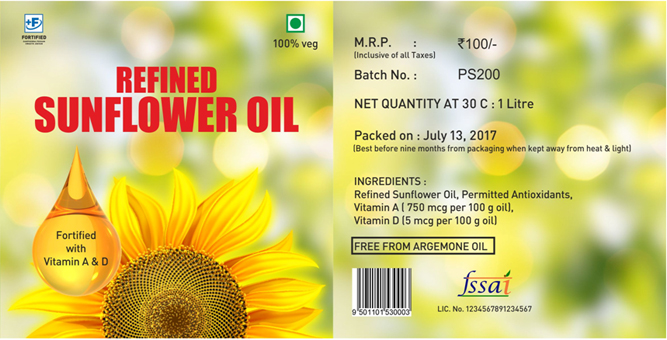38 minerals on food labels
New Food Label Spotlight: Vitamins and Minerals In the updated label, that same section will jettison vitamin A and vitamin C (the FDA asserts, "In the early 1990's, American diets lacked Vitamins A and C, but now Vitamins A and C deficiencies in the general population are rare"), replacing them with vitamin D and potassium. Calcium and iron will remain on the label. Why nutrition labels on food products? - MedClique The nutritional label: It provides the number of fats, carbohydrates, sodium, sugar, protein, vitamin, and mineral intake based on a 2000 calorie diet. The ingredient list: The ingredient list ultimately derives the nutritional value as well as help you to choose the product of your choice. Recommended daily intake: You can find the most ...
Minerals In Food - Definition, Types, Sources and Examples A balanced diet prevents mineral deficiencies. The use of vitamin and mineral supplements should be discouraged to prevent any adverse effects. Also Read: Minerals. For more information on minerals in food, its definition types, functions and sources of minerals, and examples of minerals in food, keep visiting BYJU'S Biology. You can also ...
Minerals on food labels
Vitamins and Minerals | Nutrition.gov Interactive Food Label: Vitamins and Minerals. HHS, Food and Drug Administration, Center for Food Safety and Applied Nutrition. How can the Nutrition Facts label help you to choose foods rich in vitamins and minerals? Use this interactive resource to find out! Vitamins and Minerals Chart ... Nutrition Facts Labeling — FDA Reader Macronutrients & Minerals (In order) Calcium Iron Phosphorus Iodine Magnesium Zinc Selenium Copper Manganese Chromium Molybdenum Chloride Potassium Vitamins and minerals must appear in the label if: They appear in a serving of the product When they are added as a nutrient supplement When a claim is made about them Interactive Nutrition Facts Label - Food and Drug Administration Sodium 430mg 17% Total Carbohydrate 46g 25% Dietary Fiber 7g Total Sugars 4g 4% Includes 2g Added Sugars Protein 11g 10% Vitamin D 2mcg 20% Calcium 260mg 35% Iron 6mg 6% Potassium 240mg The % Daily...
Minerals on food labels. Optional Nutrients On The Food Label - LabelCalc Since these nutrients are thought to play a more critical role in human health, they are required on the nutrition label. In addition to the above nutrients, the following nutrients are optional: Vitamin D. Vitamin E. Thiamin (Vitamin B1) Riboflavin (Vitamin B2) Niacin (Vitamin B6) Folate. Vitamin B12. Hidden Dangers Of Food Labels Women s Health Network Food labels are not required to disclose genetically modified ingredients. Some food products are labeled GMO-free to help consumers make informed choices. Why nutrition facts are misleading. ... And specific vitamins and minerals present insignificant amounts (meaning, more than 1% by weight of the total) are listed at the bottom. ... 7 Presentation of Nutrition Information on Food Labels On the food label, the percentage of U.S. RDA is "a statement of the amount per serving (portion) of the protein, vitamins, and minerals." According to FDA regulations, U.S. RDA percentages are expressed in 2 percent increments up to the 10 percent level, 5 percent increments from 11 to 50 percent levels, and 10 percent increments above the 50 ... Understanding Nutrition Facts on Food Labels - WebMD The label tells you it has no fiber or any of the key nutrients: vitamins A or C, iron and calcium. You'll notice different units of measurement on food labels. Many of the nutrients are measured...
Food Labels | Nutrition.gov Folate and Folic Acid on the Nutrition and Supplement Facts Labels HHS, Food and Drug Administration, Center for Food Safety and Applied Nutrition Learn what common foods are natural sources of the vitamin folate, plus what foods may have folic acid added during processing. Interactive Nutrition Facts Label HHS, Food and Drug Administration Understanding Food Nutrition Labels | American Heart Association Make sure you get enough of the nutrients your body needs, such as: calcium, choline, dietary fiber, iron, magnesium, potassium, and vitamins A, C, D and E.* 5 - Understand % Daily Value. The % Daily Value (DV) tells you the percentage of each nutrient in a single serving, in terms of the daily recommended amount. Food labeling: MedlinePlus Medical Encyclopedia VITAMINS AND MINERALS Vitamin D, calcium, iron, and potassium are the only micronutrients required to be on the food label. Food companies can voluntarily list other vitamins and minerals in the food. PERCENT DAILY VALUE (% Daily Value) Many nutrients include a percent daily value (%DV). How To Read Food Labels: Understanding the Basics - Instacart Other nutritional items commonly listed on food labels include cholesterol, sodium, and key vitamins and minerals such as iron, calcium, and vitamin C. Use the daily value percentage to identify the key nutrients contained within a product. In general, look for balance in your diet.
Food Labels (for Teens) - Humana - Ohio A food with 10%-19% of a nutrient is a good source of that nutrient. A food with 20% or more of a nutrient is high in that nutrient. The information on food labels is based on an average adult diet of 2,000 calories per day. The actual number of calories and nutrients that kids need will depend on their age, weight, gender, and level of ... Where are the vitamins and minerals on a nutrition labels? The Nutrition Facts label may include the following 14 minerals: Calcium, chloride, chromium, copper, iodine, iron, magnesium, manganese, molybdenum, phosphorus, potassium, selenium, sodium, and zinc are some of the minerals found in the human body. On a nutrition label, how are ingredients listed? Nutrition Labels 101: What's Required? What's Optional? 5. Trans Fat. Trans fat is the worst of the "bad fats," which is why in 2006 the FDA began requiring it to be listed separately on nutrition labels. Trans fat, like saturated fat, increases LDL cholesterol levels (i.e., "bad" cholesterol) but also lowers HDL cholesterol levels (i.e., "good" cholesterol). So it's a bit of a ... Dietary Supplement Labeling Guide: Chapter IV - FDA This results in the following order for vitamins and minerals: Vitamin A, vitamin C, vitamin D, vitamin E, vitamin K, thiamin, riboflavin, niacin, vitamin B6, folate, vitamin B12, biotin,...
Food Labels | CDC If you eat the whole thing, you are eating 8 times the amount of calories, carbs, fat, etc., shown on the label. Total Carbohydrate shows you types of carbs in the food, including sugar and fiber. Choose foods with more fiber, vitamins, and minerals. Choose foods with lower calories, saturated fat, sodium, and added sugars. Avoid trans fat.
Changes to the Nutrition Facts Label | FDA The updated label appears on the majority of food packages. Manufacturers with $10 million or more in annual sales were required to update their labels by January 1, 2020; manufacturers with less ...
Nutrient Claims on Food Labels | Home & Garden Information Center Sodium content cannot exceed 360 mg per serving for individual foods and 480 mg per serving for meal-type products. If a food is labeled "healthy" or makes a health claim, it cannot contain any nutrient that increases the risk for disease. It must contain no more than 20% of the DV per serving of total fat, saturated fat, cholesterol, or sodium.
Food Labeling: MedlinePlus With this, you can figure out if a food is high or low in a nutrient: 5% or less is low, 20% or more is high. The information on a food label can help you see how a certain food or drink fits into your overall diet. The label lists, per serving,: The number of calories. Fats, including total fat, saturated fat, and trans fat. Cholesterol. Sodium.
Understanding Food Labels - Nutrition: Science and Everyday Application The FDA uses the following definitions for interpreting the %DV on food labels:4 5%DV or less means the food is low in a nutrient. 10% to 19%DV means the food is a "good source" of a nutrient. 20%DV or greater means the food is high in a nutrient.
Figuring Out Food Labels (for Kids) - Nemours KidsHealth Food contains fat, protein, carbohydrates, and fiber. Food also contains vitamins, such as vitamin D, and minerals, such as calcium and iron. Your body needs the right combination of nutrients to work properly and grow. The Nutrition Facts label is printed somewhere on the outside of packaged food, and you usually don't have to look hard to ...
How To Read Food and Beverage Labels - National Institute on Aging There are three types of product dates commonly printed on packaged foods and beverages: "Sell by" tells how long the manufacturer suggests that a store should sell items such as meat, poultry, eggs, or milk products. Make sure you buy by this date. "Use by" tells how long items will be at peak quality.
Understanding Sugars on Nutrition Labeling - Sugar.org The goal of the Food and Drug Administration's (FDA) Nutrition Fact Label is to "ensure consumers have access to the information they need to make informed decisions about the foods they eat." 1 All Nutrition Facts Labels are required to include an Added Sugars declaration beginning January 1, 2020 for manufacturers with >$10 million in sales and January 1, 2021 for manufacturers with ...
PDF Interactive Nutrition Facts Label - Vitamins and Minerals Chart wwwaovnutritioneucation Vitamins and Minerals Chart 1 Vitamins. VITAMIN WHAT IT DOES. WHERE IT IS FOUND DAILY; VALUE* Biotin ... • Conversion of food into energy • Digestion • Fluid balance • Nervous system function Olives ... Interactive Nutrition Facts Label - Vitamins and Minerals Chart





Post a Comment for "38 minerals on food labels"